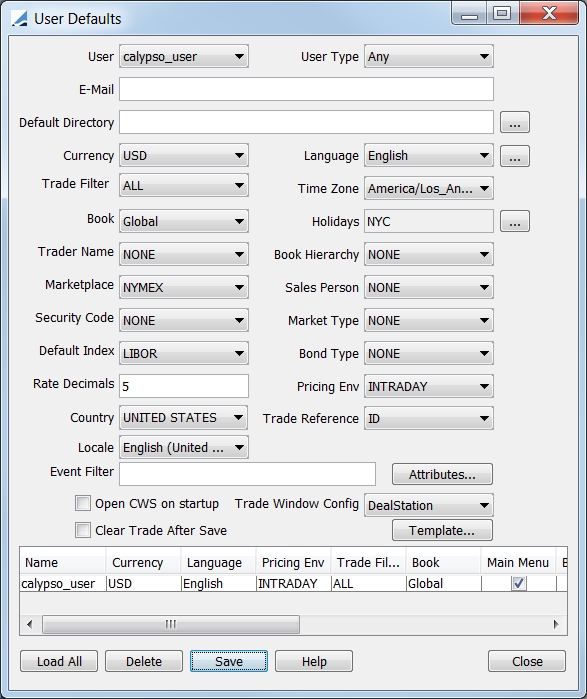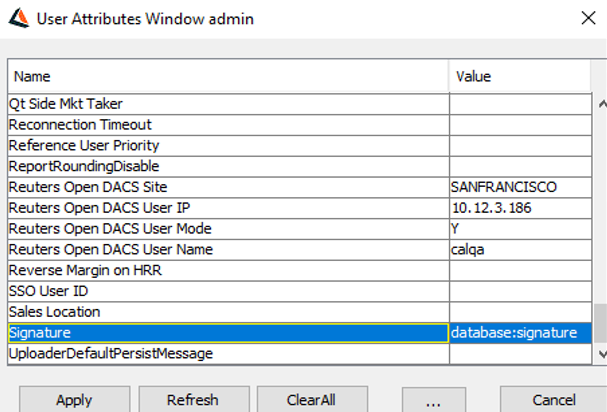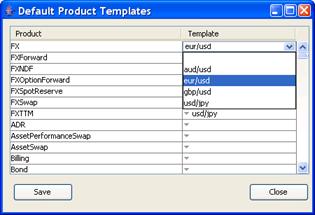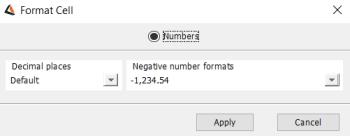Defining User Defaults
Once you have logged into the Calypso Navigator, you may want to set up default values for various fields. They will mostly be used in trade worksheets, and will apply to your user name only.
From the Calypso Navigator, navigate to Configuration > User Access Control > User Defaults (menu action refdata.UserDefaultsWindow) to define default values.

| » | Select a user and edit the fields as applicable. The fields are described below. Then click Save to save your changes. |
| » | You can click Load All to load all users. |
| » | You can click Attributes to specify User Defaults attributes as applicable. |
 See Out-of-the-Box Attributes for details on attributes provided out-of-the-box.
See Out-of-the-Box Attributes for details on attributes provided out-of-the-box.
You can set your signature on the trade confirmation messages by setting the Workflow rule "AppendSignature" with the specific manual action 'SIGN' and message keyword "APPROVAL_SIGNATURE". The value of the signature will be a link to an image file stored in the image repository.

When the workflow rule is set, a pop-up is displayed to approve and append the signature:
If you select yes, then User Defaults > Attributes > Signature is set and confirmation will be generated with the signature.
If you select no, then User Defaults > Attributes > Signature is not set, confirmation will be generated with empty signature, and a task “No signature found for user ‘username’" is created.

| » | You can click Templates to select default trade templates per product type. |

Then click Save to save the default templates.
When you open the corresponding trade window, the template will be loaded by default.
Fields Details
|
Fields |
Description |
|---|---|
|
User |
Select a user. |
|
User Type |
Select a user type: Sales, System, Trader or Any. The user type is for information purposes only. User types are defined in domain "UserTypes". |
|
|
Enter the default email address as needed. It will be used when you send messages through the EMAIL gateway. |
|
Default Directory |
Click ... to select the default directory. It will be used to store documents and reports. If not specified, the system's user directory will be used. Example: |
|
Currency |
Select the default currency. New trades default to this currency. Currencies are created from the Calypso Navigator using Configuration > Definitions > Currency Defaults.
|
|
Language |
Select the default language (used mainly for messages). You can click ... to add a language. |
|
Trade Filter |
Select the default Trade Filter to load trades. Trade filters are user-defined collections of trades. They are created from the Calypso Navigator using Configuration > Filters > Trade Filter.
|
|
Time Zone |
Select the default time zone in which the user operates. |
|
Book |
Select the default trading book. Trading books are created from the Calypso Navigator using Configuration > Books & Bundles > Trading Book.
|
|
Holidays |
Select the default holiday calendar. This calendar is used when there is no holiday calendar specified in the Currency Defaults. It is also used when there is no holiday calendar specified for running scheduled tasks in the Trigger Definition Window. You can click ... to add all calendars that apply. Holiday calendars are created from the Calypso Navigator using Configuration > Definitions > Holiday Calendars.
|
|
Trader Name |
Select the default name of the trader capturing trades. Trader names are defined in the "trader" domain. |
|
Book Hierarchy |
Select the default book hierarchy for sorting trades and positions in reports. Book hierarchies are created from the Calypso Navigator using Configuration > Books & Bundles > Book Hierarchy.
|
|
Marketplace |
Select the default market place where the trades are captured. A market place is a legal entity of role "MarketPlace". |
|
Sales Person |
Select the default name of the sales person initiating trades. Sales persons are defined in the "salesPerson" domain. If the domain salesPerson is empty (and only in that case) and the Sales Person is set to blank in the User Defaults, the Sales Person field defaults to blank in the trades. |
|
Security Code |
Select the default security code (ISIN, CUSIP, INTERNAL, etc) to display on trade entry windows for position-based products. Security codes are created when defining products. |
|
Market Type |
Select the default market type of the trades you enter. Market types are created when defining bond products. |
|
Default Index |
Select the default interest rate index. Rate indices are created from the Calypso Navigator using Configuration > Interest Rates > Rate Index Definitions.
|
|
Bond Type |
Select the default bond type. Bond types are created when defining bond products. |
|
Rate Decimals |
Enter the default number of decimals you want to display for interest rate indices. For example, if the Rate Decimals field is set to 5 for a particular user, in the swap trade window, the fixed rate 6.123456 will be displayed as 6.12345. Ⓘ [NOTE: A currency's Rate Decimals setting in the Currency Default window normally takes priority over the Rate Decimals setting in the User Defaults window. However, if you enter -1 for Rate Decimals in the Currency Default window, this will give priority to the setting specified in User Defaults. See "Defining Currencies and Currency Pairs" in the Getting Started documentation for further details] |
|
Pricing Env |
Select the default Pricing Environment. Pricing environments are created from the Calypso Navigator using Market Data > Pricing Environment > Pricing Environment
|
|
Country |
Select the default country. Countries are created from the Calypso Navigator using Configuration > Definitions > Countries.
|
|
Locale |
Setting the Locale here enables different users to be logged in to the same data server but each using a different locale. The value set in this field overrides the value set in the Environment. |
|
Trade Reference |
Select the default trade reference for selecting trades: ID, Ext Ref, or Int Ref. In trade windows and reports, you can load individual trades based on the trade id (ID), external reference or internal reference.
The internal reference and external reference can be set in the Details panel of the trade worksheets. |
|
Event Filter |
Enter a filtering string as needed to filter the events that the user will receive - For example, Trader=Andy. Note that this string will only be processed by the event server provided custom processing classes have been implemented. Refer to the Calypso Developer’s Guide section “Event Filtering” for complete details. Workflow Tasks Filtering If you set the Event Filter to Task, tasks will be filtered on the server side based on the Task Station User Defaults if they contain a task internal reference. As a result, the Task Station of the user will only receive those task events that match the specified task internal reference.
|
|
Show Main Trade Menu |
Check this box to display the Trade menu from the Calypso Navigator, or hide it otherwise. When the Trade menu is hidden in the Calypso Navigator, you can capture trades from the Trade Blotter. |
|
Trade Window Config |
In some cases, Calypso provides various implementations of the same trade window, and it also allows invoking custom trade windows. The trade window configuration allows associating a trade window with a given implementation, other than the default. Select the trade window configuration here. You need to restart the Calypso Navigator in order for the change to take effect. Trade window configurations are created from the Calypso Navigator using Configuration > User
Access Control > Trade Window Configuration (menu action
|
|
Clear Trade After Save |
When this flag is checked, after you save a trade, the trade window clears the trade and restores the trade window to the default template values. Ⓘ [NOTE: This feature currently only applies to FX trade windows (Spot, Fwd, Swap, Spot Reserve, TTM, NDF and Opt Fwd), including FX Pricer in Front Office Workstation.] |
The following attributes can be set out-of-the-box.
|
Attributes |
Description |
||||||
|
ArbitrageSolveForPreference |
Default lock preference for Arbitrage window. you can select Point, PrimaryInterest or SecondaryInterest.
|
||||||
|
Average Price Per Hour |
To calculate the cost of a STP break.
|
||||||
|
BOBrowser Trade Reference |
Default trade reference for the BO Browser. It can be ID or Int Ref. It only applies when the BO Browser is open from a Trade window. |
||||||
|
Bloomberg IP Blommberg UUID Bloomberg User Mode |
|
||||||
|
Close FOWS QTE After Position Split Transfer |
If true, the Position split/transfer pop up QTE will automatically close after trade is booked. If false (default) , the Position split/transfer pop up QTE will not close automatically. |
||||||
| Default Ad-Hoc Calculation Server |
Default adhoc Calculation Server to be used for on-the-fly risk analyses. A Calculation Server is part of a Risk Server.
|
||||||
| Default Ad-Hoc Presentation Server |
Default Presentation Server to be used for on-the-fly risk analyses. A Presentation Server is part of a Risk Server.
|
||||||
| Default Dispatcher |
Default dispatcher to be used for on-the-fly risk analyses in the Trade Blotter.
|
||||||
|
Default Pricing Grid Auto Update Dispatcher |
Default dispatcher configuration to compute pricing results in the Pricing Grid and FOWS Market Sheet. |
||||||
|
EDealingOrderBlotterShowAlertsTab |
True to show the Alerts tab in the ePortals Order Management window or false otherwise. |
||||||
|
EDealingOrderBlotterShowImportExportTab |
True to show the Import Export tab in the ePortals Order Management window or false otherwise. |
||||||
|
EDealingOrderBlotterShowOperatingSystemTrayAlerts |
True to show the Operating System Tray Alerts in the ePortals Order Management window or false otherwise. |
||||||
|
EDealingOrderPendingBlotterMinRefreshInterval |
Default refresh interval of the Pending Orders Blotter in the ePortals Order Management window. |
||||||
|
EdealingTIMPendingSearchStatus |
Default status for Pending Search Status field in eFX Configuration window.
|
||||||
|
EMA Open DACS AppId EMA Open DACS Daemon EMA Open DACS ForceUserNameLowerCase EMA Open DACS Retry Rate EMA Open DACS Site EMA Open DACS UsageLoggingType EMA Open DACS User IP EMA Open DACS User Mode EMA Open DACS User Name |
|
||||||
|
Employee Id |
Employee identifier, as needed. |
||||||
|
FX Auto Populate TakeUp Amounts |
True to auto populate the remaining amount on Take Up window, or false otherwise. |
||||||
|
FX Default Broker |
Not used. |
||||||
|
FX Default CounterParty |
Not used. |
||||||
|
FX Default Currency Pair |
Select the default currency pair that loads in the trade window when you open it. |
||||||
|
FX Default Current Trade Datetime Flag |
True to check Current Trade Dt field be default in FX Deal Station, or false otherwise. |
||||||
|
FX Default Deal Type |
The default deal type that is displayed when the FX Deal Station window is opened. Select either Outright or Swap. |
||||||
|
FX Default Deliverable Type |
Select either Deliverable or Non Deliverable. |
||||||
|
FX Default Delivery Type |
Not used. |
||||||
|
FX Default Override Ccy As Deliverable |
Currencies to be considered as deliverable in the FX Deal Station even if the Currency Defaults setting is Non-Deliverable.
|
||||||
|
FX Default PositionKeepingBookType.SALES Disable Trade Routing |
True to disable trade routing for the Sales book, for both internal and counterparty trades. Or false otherwise.
|
||||||
|
FX Default Prime Broker |
Not used. |
||||||
|
FX Default Rollover Type |
Default rollover type for FX Trade Rollover window.
|
||||||
|
FX Default Spot Delivery Type |
Select either Known or Unknown. The values for the button are 'Delivery Known' and 'Delivery Unknown'.
|
||||||
|
FX Default Trade Region |
Default trade region for ePortals.
|
||||||
|
FX Default Trade Role |
Not used. |
||||||
|
FX Spot Delivery Type |
Not used - Use FX Default Spot Delivery Type. |
||||||
|
FX Termination Book Spot Trade Simultaneously |
Default value for Book Spot Trade Simultaneously field in FX Termination window.
|
||||||
|
FX User Type |
Select whether the default FX user is Sales or Trader. |
||||||
|
FX WindowForward Default End Tenor |
Default window end tenor for a new FX Window Forward trade in the FX Deal Station. |
||||||
|
FX WindowForward Default Start Tenor |
Default window start tenor for a new FX Window Forward trade in the FX Deal Station. |
||||||
|
FXFlexiForward Default End Tenor |
Default end tenor for a new FX Flexi Forward trade in the FX Deal Station. |
||||||
|
FXFlexiForward Default ShortDays Strategy |
Default ShortDays Strategy for a new FX Flexi Forward trade in the FX Deal Station. |
||||||
|
FXFlexiForward Default Start Tenor |
Default start tenor for a new FX Flexi Forward trade in the FX Deal Station. |
||||||
|
FXFlexiForward Default TakeUp Type |
Default TakeUp Type for a new FX Flexi Forward trade in the FX Deal Station. |
||||||
|
FXFlexiForward Default Window Type |
Default Window Type for a new FX Flexi Forward trade in the FX Deal Station. |
||||||
|
FXForward Default Tenor |
Default tenor to set the settlement date for FX Forward trades, applied to the spot date. If not set, the settlement date is set to the spot date. |
||||||
|
FXForwardStart Default Reset Tenor |
Default Reset Tenor for a new FX Forward Starting Trade in the FX Deal Station. |
||||||
|
FXForwardStart Default Underlying Type |
Default Underlying Type for a new FX Forward Starting Trade in the FX Deal Station. |
||||||
|
FXNDF Default Negotiated Ccy |
Default Negotiated Ccy for FX NDF trades. |
||||||
|
FXNDF Default Tenor |
Default tenor to set the settlement date for FX NDF trades, applied to the spot date. If not set, the settlement date is set to the spot date. |
||||||
|
FXNDFSwap Default Far Tenor |
Default tenor to set the settlement date for FX NDF Swap trades (far leg), applied to the spot date. If not set, the settlement date is set to the spot date. |
||||||
|
FXNDFSwap Default Near Tenor |
Default tenor to set the settlement date for FX NDF Swap trades (near leg), applied to the spot date. If not set, the settlement date is set to the spot date. |
||||||
|
FXSwap Default Far Tenor |
Default tenor to set the settlement date for FX Swap trades (far leg), applied to the spot date. If not set, the settlement date is set to the spot date. |
||||||
|
FXSwap Default Near Tenor |
Default tenor to set the settlement date for FX Swap trades (near leg), applied to the spot date. If not set, the settlement date is set to the spot date. |
||||||
|
Historic Rate Rollover |
Specify the default funding rate for rollovers done from the trade window by choosing File > Trade Rollover when the trade is in the VERIFIED status. The value ‘true’ specifies that the historical rate will be used in the rollover. The HRR checkbox is automatically selected when you open the FX Rollover Split application. Set the attribute to ‘false’ so that the market rate is used by default. The HRR checkbox is not selected when you open the trade rollover application. |
||||||
| Load Min Product Info |
Not used. |
||||||
|
Manual Quote Expiry(secs) |
Not used. |
||||||
| Market Data Server Config |
Select the Market Data Server configuration that you want to use. Running a Market Data Server is required to obtain any kind of real-time market data. A Market data Server is part of a Risk Server.
|
||||||
| Max Number of Reconnections |
Not used. |
||||||
| NumberFormat |
Select the format of negative numbers for the Results area of all Trade windows and to the pricer measure DETAILED_DATA. You can select the number of decimal places and the format: -<number> in black or red, or (<number) in black or red.
|
||||||
|
PDFConfig |
PDF configuration file for environment property PDF_DOCUMENT_FONT.
|
||||||
|
PosRefCurPairs |
At the system level, you can define currency pairs in both the direct and inverse order, such as USD/JPY and JPY/USD, in the Calypso Navigator using Configuration > Definitions > Currency Definitions. However, trades entered in both currency pairs appear in one position. The currency pair that has the Pair Pos Ref checkbox selected is the position reference currency pair. However, if you trade the opposite currency pair locally (for example JPY/USD), you can set that currency pair as the position reference at the user level. You can enter multiple currency pairs separated by commas in the attribute. |
||||||
| Pricing Sheet Default Book |
Default book for the FX Options Pricing Sheet. |
||||||
| Pricing Sheet Pricing Environment |
Default pricing environment for the FX Options Pricing Sheet. |
||||||
|
Qt Side Mkt Maker |
Configure the display of quotes as either Market Maker or Sales Trader by setting the Qt Side Mkt Maker attribute in User Defaults.
|
||||||
|
Qt Side Mkt Taker |
Not used. |
||||||
| Reconnection Timeout |
Not used. |
||||||
|
ReportRoundingDisable |
True to export reports to ExcelX spreadsheets without rounding the amounts, or false otherwise. |
||||||
|
Reuters Open DACS Site Reuters Open DACS User IP Reuters Open DACS User Mode Reuters Open DACS User Name |
|
||||||
|
Reverse Margin on HRR |
When this is set to True, the sales margin will follow the Japanese convention, which means that a sales margin is booked as profit on the trade date but not received until settlement. |
||||||
|
SSO User ID |
Microsoft Azure AD name or email depending on CALYPSO_OPENID_USER_NAME.
|
||||||
|
Sales Location |
Default sales location. |
||||||
|
Trade Blotter Calculation Server |
Not used. |
||||||
|
Trade Blotter Dispatcher |
Not used. |
||||||
|
Trade Blotter Presentation Server |
Not used. |
||||||
|
Try Opening Trade in FOWS First |
By default, the system tries to open FX trades in the Front Office Workstation, or using the Trade Window Config if not configured. You can set to false to only use the Trade Window Config.
|
||||||
|
UploaderDefaultPersistMessage |
Default value for Persist Message field in Data Uploader window. |
||||||
|
USE_FX_MARGIN_RULES_FOR_TRADE_ENTRY |
By default, FX Margin Rules are applied to Margin fields in the FX Pricer. You can set to false if you do not want to use the FX Margin Rules.
|
||||||
|
DefaultZebraBackgroundColor ZebraRowColor |
Select the default background color. This applies to the Results area of all Trade windows and to the pricer measure DETAILED_DATA. Select the background color of every other row. This applies to the Results area of all Trade windows and to the pricer measure DETAILED_DATA.
|


